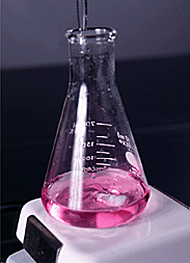Standard level
Chemical compounds contain elements in an exact mole ratio. This mole ratio gives the formula of the compound. Two elements may form between one and many compounds, each with a different specific ratio of moles.
For example, hydrogen and oxygen form two completely different compounds, water and hydrogen peroxide with formulae H2O and H2O2 respectively.
Many metals form several oxides, each with a different ratio of the elements.

Background
Oxides of relatively unreactive metals can be reduced to metal by heating in a flow of hydrogen or methane gas.
Reduction of copper(II) oxide
CuO(s) + H2(g) → Cu(s) + H2O(g)
If the mass of the metal oxide is recorded and the mass of the metal residue is also recorded, the mass of oxygen lost can easily be determined.
The mol of oxygen can then be calculated and if the identity of the metal is known, the formula of the metal oxide can be determined.
This experiment can be performed in the laboratory, if suitable safety precautions are taken.
- After reading the animation above, advance to the second page and click on the "collect data" button.
- Record the data and use the data processing section to determine the formula of the metal oxide.
- Fill in your answer (do not worry about sub-scripts) and press the "chck answer" button.
- Record at least 5 sets of data.
Although the reaction can be performed in the laboratory as a demonstration or student experiment, there are some safety issues to be aware of.
- Hydrogen and methane gases are highly flammable and makes an explosive mixture with air or oxygen.
- Allow the gas to run through the tube completely, flushing any remaining air out of the tube before igniting the gas outflow. This is ignited to prevent gas filling the laboratory.
- The metal oxide must be heated thoroughly for complete reduction.
- Once reaction has completed, turn off the Bunsen burner, but keep the gas flowing through thetube to prevent re-oxidation of the hot metal. This should continue until the test tube is cool.
The animation can be projected full screen here.